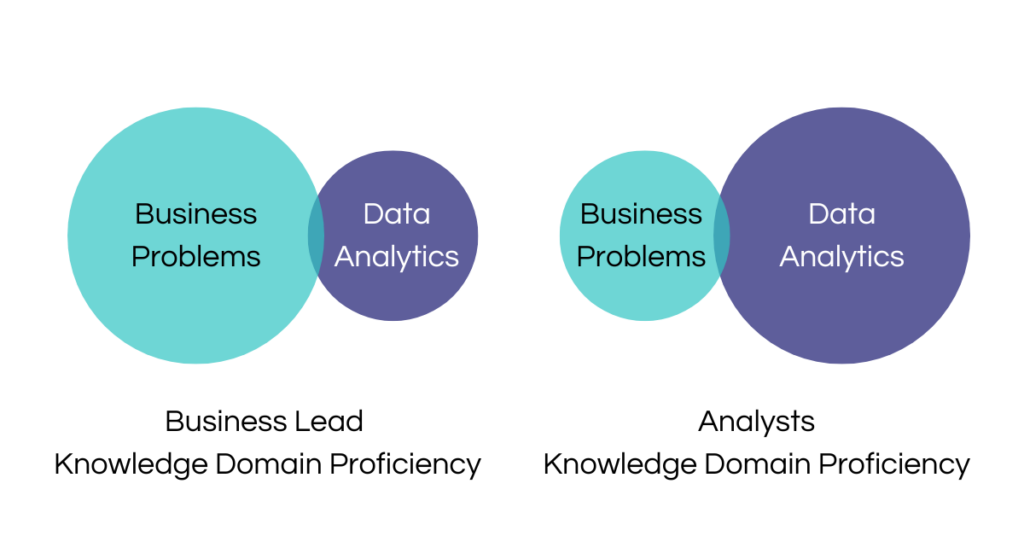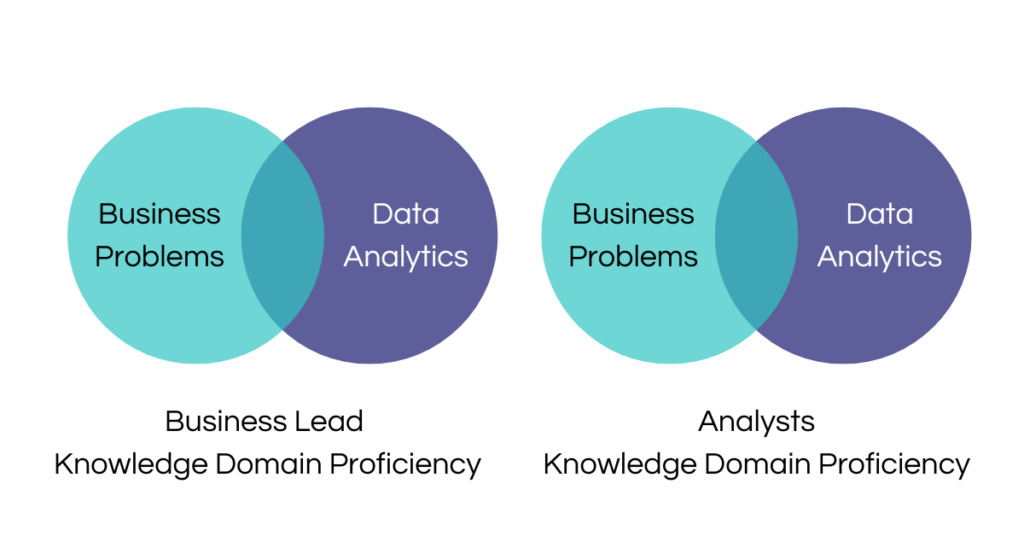If this article caught your attention, then I’m guessing you have experienced challenges integrating analytics into your business units. Technical people often don’t fully understand business problems. Leadership often doesn’t fully understand analytic methodology and workflow. But the solution to these challenges is deceptively simpler than most people want to admit. Integrating your analytics boils down to communication skills, and nearly all major challenges are caused by a lack of communication.
It’s Not Your Organizational Structure
At least a few of you are thinking there are many factors besides communication needed to integrate analytics. What about finding the best organizational structure?
Your choice of organizational structure for analytics might be centralized, decentralized, or federated. Each structure comes with its pros and cons, and none are clearly superior to the others.
Your choice of organizational structure for analytics will be driven by the context and needs of your organization. Adapting your existing business units and processes to integrate analytics will require changes in the status quo. And you may need to adjust on the fly to find the best option for your organization.
That being said, there is nothing inherent about any organizational structure that promotes or prevents you integrating analytics. Organizations achieve success everyday using all three models for analytics.
No, the success of your analytics structure will hinge on the clarity and effectiveness of communication throughout the organization.
Communication Starts from the Top
Integrating your analytics requires that communication of critical business concepts start from the top with leadership. Leadership needs to take the initiative because of the hierarchical difference between the decision-makers and analytics. And you will be best positioned to achieve clarity by beginning with the end in mind.
Ideally, your organization has key information written down where others can access it. Your analysts need to understand the business model, strategic vision, and key business problems and priorities. Analysts will understand better how their work impacts the organization when they have clear access to this information.
Providing strategic information about your general business structure and priorities needs to be coupled with tactical information for specific analyses. Analysts need to understand why a particular analysis is relevant, who the audience is, and how results will be used.
Communicating Uphill Requires Assistance Top
Communication is a two-way street, requiring that both parties understand the other to establish effective channels. When you integrate analytics, communication should start from the top with clarity and accessibility. Analysts need to frame results appropriately to communicate them up the organizational. To be effective, analysts often need assistance knowing what information and how to communicate results back to leadership.
You may have experienced breakdowns in this process before. Have you ever received results from your analytic team that were purely in technical terms? You probably wondered (among other thoughts) why they didn’t translate the results into plain language.
With experience, analysts learn to effectively communicate with leadership. Leadership needs and styles, however, will vary from one organization to another. Effective analytic integration therefore hinges in part on analysts understanding how to ask what leadership wants for results. For its part, leadership needs to provide analysts with assistance explaining how results should be conveyed.
Does leadership want only plain language results, or will they want some technical information as well? What level of detail is expected – just the punchline, or supporting evidence as well? How granular does leadership want the caveats and conditions to be? What degree of documentation is analytics expected to provide?
This is not all to say that the responsibility for effective communication lies solely in leadership. Not at all. A substantial portion of the responsibility falls to analytics for determining how they will communicate results back.
Structural Hierarchy, Technical Skill, and Information Flow
Three key concepts help frame the communication challenges when you attempt to integrate analytics. At the outset, begin by reframing your analytic integration effort as an issue of information flow. Within that flow, you will need to be cognizant of the differentials in the structural hierarchy and technical skill. Both of these differentials have an impact on the effectiveness of information flow that you need to consider carefully.
Considering analytic integration as an information flow problem
From an operational perspective, integrating your analytics into the business hinges on leadership developing appropriate information flows. Here, I am talking about information flows in a literal sense. How do business unit leaders transmit requests for analyses, and how do analysts return the results? As with any communication method, you must contend with issues of synchronicity, noise, and information loss.
Synchronicity refers to whether the communication paths are one-way, or two-way. Synchronous communication, such as face-to-face discussion and phone calls, allow you to have easy two-way interaction. In contrast, asynchronous tools like email and messaging apps only provide you with one-way communication. The receiver cannot easily ask clarifying questions or provide feedback about their understanding.
Noise enters communication when senders add extraneous information to their messages. The additional information may occur due to misinterpretations of the original message, or well-intentioned efforts to provide supplemental information. Regardless of the source, senders adding noise alter the intended focus or meaning of the message, possibly confusing the receiver.
Information loss occurs when senders create incomplete messages in the chain of communication. This often happens inadvertently when senders use email or instant messaging. With these tools, receivers have less opportunity to ask questions or signal that they do not fully understand the message.
Senders attempting to shorten requests for greater efficiency may also inadvertently cause information loss. They may omit seemingly inconsequential information without realizing its importance.
Your team experiences the challenges of synchronicity, noise, and information loss in all communications to greater or lesser degrees. When you are integrating analytics, however, additional factors can play a substantial role in the quality of the result. Specifically, the relationship between business leads and analytics will be conditioned by differences between the groups in terms of structural hierarchy and technical skills.
How Differences in Structural Hierarchy Impact Information Flow
Structural hierarchy refers to different levels of authority within the organization.
Business leads often hold higher levels of authority than analytic teams. Therefore, the communication flow can be skewed to make communication from the top down easier, while reducing the flow of information from the bottom up.
Business leaders and analysts separated by large differences in hierarchical structure experience greater chance for communication noise and information loss. Additionally, there are often barriers to analysts asking follow-up and clarifying questions.
In the worst-case scenarios, business leads actively restrict follow-up communication by pushing the responsibility down in the hierarchy. For example, a VP lets a director know that they are responsible for translating/managing requests. In these cases, clarifying questions never get back to the original requestor and the request may be misinterpreted.
Only slightly less problematic are situations where analysts do not ask follow-up questions for fear of appearing less than experienced. It is frequently a surprise to new analysts when they find out how much they didn’t learn in school. It is common for new analysts to avoid asking questions in the attempt to figure everything out on their own.
Ideally, the process of requesting analyses will include the opportunity for business leads and analysts to plan and discuss the project in greater detail, including truly synchronous feedback and clarification. Read more about the analytic planning process here.
How Differences in Technical Skill Impact Information Flow
I use the term technical skills to refer to both knowledge domains of analytic ability and knowledge of business problems. Often, business leads have greater knowledge of business problems and priorities than analysts. Similarly, analytic teams have greater knowledge of statistical, data, and programming issues than business leads. For both groups, domain knowledge differences impact their abilities to translate ideas into terms the other group can easily understand.
Consider the Venn diagrams in figure 1. The size of the circles represents the proficiency of an individual in the subject matter. The overlap indicates the ability of the individual to translate between the topics fluently. The differences in these diagrams between business leads and analytic teams illustrates the knowledge gap between the two groups.
Figure 1. The Knowledge Domain Proficiency Gap

Organizations can increase effective communication between business leads and analysts by increasing parity in domain knowledge proficiency. Organizations achieve additional efficiencies by providing at least one group with sufficient fluency to translate between the two skill sets. See the illustration in figure 2.
Figure 2. Knowledge Domain Proficiency Parity

Business leads often request that analysts return their results in non-technical language that maximizes decision-making ability. Analysts experience challenges doing this when they lack sufficient skill with business problems and priorities. Analysts need time to develop that skill through experience and effort.
Business leads should therefore acquire greater knowledge of data analyses to better translate between business problems and analytic projects. Fortunately, improving data analytic knowledge does not require deep knowledge of mathematical statistics or programming. Business leads with a solid conceptual understanding of analytics can achieve the necessary results.
Conclusion
Organizations in the process of standing up and integrating analytics teams encounter many challenges along the way. Business leads and analytic teams need clear two-way communication to overcome many of these challenges. In particular, organizations will benefit most from synchronous communication channels allowing for greater clarity and less information loss. Importantly, teams must also work to mitigate any communication issues influenced by the organizational hierarchy.
Business leads and analytic teams need to recognize the differences in domain knowledge between the two groups. Organizations improving staff proficiency in business problems and data analytics will experience improved communication and greater efficiency integrating analytics. Finally, organizations improving staff fluency in translating across knowledge domains will experience greater gains in efficiency and effectiveness.




